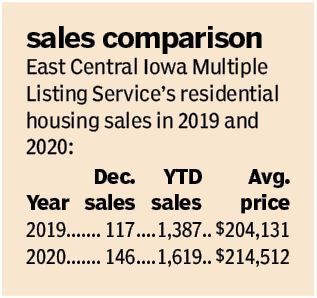In many corners of the economy, 2020 was a year marked by reduced activity and sales declines.
The opposite phenomenon unfolded in the local real estate industry.
East Central Iowa Association of Realtors reported that 1,619 homes were sold in the Dubuque area in 2020, a 17% increase compared to the previous year. Average sales prices, meanwhile, increased 5% to nearly $215,000.
Sherry Spahn, president of East Central Iowa Association of Realtors, said the unique circumstances of the past year changed the way people thought of their homes.
“Some people were working from home. Some were using it for a learning space. Others were using it as a workout area when they couldn’t go to the gym,” she said. “In 2020, a lot of people decided they needed a change to accommodate those new circumstances.”
Spahn emphasized that sales were further fueled by low interest rates, which made the financial realities of buying a home more palatable for prospective homebuyers.
Interest rates have hovered around historic lows for years, driving up demand in the real estate market. The continuation of this trend, coupled with the ongoing belief that such rates will inevitably rise, convinced buyers to cash in on the low rates while they can.
“Some buyers were considering purchasing a home but didn’t plan to do so for another year or two,” Spahn said. “For those people, I think they looked at the circumstances and decided to move up their plans.”
Widespread growth
The increase in home sales also was evident in southwest Wisconsin.
Deb Jenny, a broker with Platteville Realty, said there were 455 home sales in Grant County in 2020, significantly outpacing the 406 sales recorded the previous year. These homes sold at an average price of $173,179, representing a major increase over the previous year’s average of $150,230.
While the economy as a whole didn’t flourish in 2020, Jenny emphasized that many people still had some extra money to spend.
“I think more people were ready to buy because they weren’t spending their money other places,” she said. “They weren’t going out to eat or taking a lot of trips.”
Jenny said that midway through the year, it became apparent that 2020 had the potential to be a solid year in the real estate market. That possibility wasn’t always clear, however.
“Back in the spring, this really didn’t seem like it would be a boom year,” she said. “I was just hoping things would remain steady until we could get everything straightened out (with the pandemic).”
Slowly, but surely, Realtors, buyers and sellers began to adapt to the new protocols made necessary by the pandemic, which included everything from wiping down the surfaces in a home that was on the market to requiring that prospective buyers wear masks while inside. Jenny noted that virtual tours also became more popular.
In northwest Illinois, officials have not yet calculated the final home sales or price totals from 2020.
Ginger Sreenan, executive officer at Realtor Association of Northwestern Illinois, said the past year was an ideal one for sellers in the region.
“The low inventory and low interest rates really put sellers in a good position,” she said. “They sold their homes quickly and often had multiple offers, which increased the average price.”
Staying optimistic
At a time when forecasting any aspect of the future is tricky, area Realtors are largely confident that 2021 will be a strong year in the market.
“My crystal ball is a little hazy. Anything can happen,” Jenny said. “But I am hopeful we will see more of the same. There are a lot of people still interested in buying a home, and I think people are becoming more optimistic about the economy.”
Spahn expressed a similar sentiment, noting that she doesn’t anticipate “anything drastic” in terms of rising interest rates in the year ahead.
“I definitely am optimistic about 2021,” she said.
Jenny said the eventual rise of interest rates is inevitable, noting that the cost of borrowing likely will start to tick upward around the time that struggling parts of the economy, including the hospitality industry, begin to show signs of recovery.
Considered within a broader historical context, however, she believes that interest rates will remain relatively low and put home purchases within reach for prospective buyers.
“Back in the 1980s, we used to see interest rates up around 15 to 18%,” she recalled. “I don’t imagine we’ll ever see anything like that again.”



